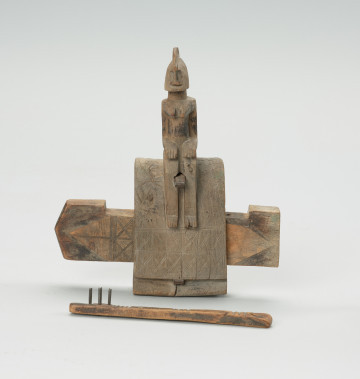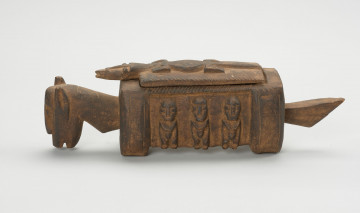
Door lock with key
circa 1970
National Museum in Szczecin
Part of the collection: Collection of Dogonian art
The Dogon are people living in the Republic of Mali. The basis of their economy is hoe-farming. Many of the Dogon annual rituals are connected to ensuring a good harvest. To this end, they thank the god Amma and their ancestors for a good harvest and ask for blessings for the coming field season. The two most important festivals in the agricultural calendar are Goru and Bulo, during which the priests of both cults of life - Hogon (priest of the Lebe cult) and Binukedine (priest of the Binu cult) - cooperate. The sign for the beginning of the Goru festival is an offering made by Binukedine on an altar called teni ama. All ancestors, including mythical ones, are remembered on this occasion, and a time is set for holding the Dama funeral festival for those who have died in recent years. On the eve of the festival, young uncircumcised boys go into the bush to construct a momo altar. They then make offerings on it to ensure fertility for people and livestock. This is the first stage of initiation into adult life.For the festival of Goru, the wives of the patriarchs of the great families (ginna bana) prepare a special kind of konyo beer from newly harvested millet. They must go alone, unseen by anyone, to fetch the water needed to brew the drink. The beer is not fully fermented, as the brewing process is very short and lasts only 2-3 days. It is called pipilu (or konyopilu - white beer). The drink, in the evening, on the day before the start of the holiday, is poured into all the vessels located at the altars of wagem dedicated to the deceased relatives. The rest will be consumed by the Dogon during the Goru celebrations.
Ewa Prądzyńska
Author / creator
Dimensions
cały obiekt: height: 54 cm, width: 7,5 cm
Object type
figure
Creation time / dating
Creation / finding place
Identification number
Location / status

circa 1970
National Museum in Szczecin

między 1951 — 2000
National Museum in Szczecin

między 1901 — 1950
National Museum in Szczecin
DISCOVER this TOPIC
Museum of King Jan III's Palace at Wilanów
DISCOVER this PATH
Educational path